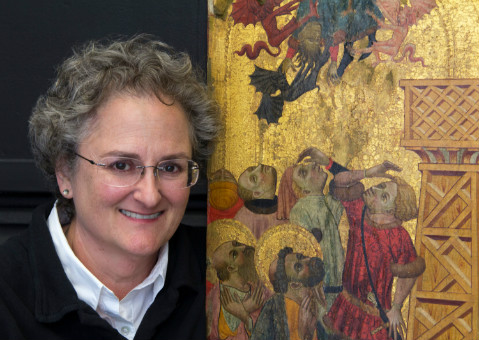- Events & Programs Home
- Calendar
- Accessibility
- Adults
-
Families & Teens
- Families & Teens Home
- 10x10 Teen Art Expo
- Art on the Rise
- Art Together: Art Making for Families with Children Ages 3–5
- Babies Sing with May Festival Minis
- Boy Scouts / Girl Scouts
- CAM Kids Day
- Family Storytime and Gallery Walk
- Family Studio: Art Making for Families with Children Ages 6–12
- Games in the Galleries
- Members-Only Baby Tours
- Public Baby Tours
- REC Reads
- Rosenthal Education Center (REC)
- Saturday Morning Art Class
- See Play Learn Kits
- Summer Camp
- Teachers
- Community Outreach
- Fundraisers
- Plan Your Own Event

- Events & Programs Home
- Calendar
- Accessibility
- Adults
-
Families & Teens
- Families & Teens Home
- 10x10 Teen Art Expo
- Art on the Rise
- Art Together: Art Making for Families with Children Ages 3–5
- Babies Sing with May Festival Minis
- Boy Scouts / Girl Scouts
- CAM Kids Day
- Family Storytime and Gallery Walk
- Family Studio: Art Making for Families with Children Ages 6–12
- Games in the Galleries
- Members-Only Baby Tours
- Public Baby Tours
- REC Reads
- Rosenthal Education Center (REC)
- Saturday Morning Art Class
- See Play Learn Kits
- Summer Camp
- Teachers
- Community Outreach
- Fundraisers
- Plan Your Own Event
Blog: CAM Uncovered
Blog: CAM Uncovered
- Home
- Plan Your Visit
- Art
-
Events & Programs
- Events & Programs Home
- Calendar
- Accessibility
- Adults
-
Families & Teens
- Families & Teens Home
- 10x10 Teen Art Expo
- Art on the Rise
- Art Together: Art Making for Families with Children Ages 3–5
- Babies Sing with May Festival Minis
- Boy Scouts / Girl Scouts
- CAM Kids Day
- Family Storytime and Gallery Walk
- Family Studio: Art Making for Families with Children Ages 6–12
- Games in the Galleries
- Members-Only Baby Tours
- Public Baby Tours
- REC Reads
- Rosenthal Education Center (REC)
- Saturday Morning Art Class
- See Play Learn Kits
- Summer Camp
- Teachers
- Community Outreach
- Fundraisers
- Plan Your Own Event
- Give & Join
- About
- Tickets
- Calendar
- Exhibitions
- Collections
- Blog
- Shop
Cincinnati Art Museum’s Conservation on View: Zaragoza’s Retablo of St. Peter
by Marketing Dept.
1/11/2016
conservation , behind the scenes , paintings , Zaragoza , paintings conservation , Serena Urry
Behind the scenes conservation work moves out of the Conservation Lab to provide a work-in-progress exhibition from January 26 – April 24, 2016. Conservation on View: Zaragoza’s Retablo of St. Peter will let visitors peek into the workings of the skilled employees who are in charge of preserving and protecting works of art at the Cincinnati Art Museum.
Chief Conservator Serena Urry will be cleaning the Retablo of St. Peter by Lorenzo Zaragoza (c.1340-c.1410), the first step of a major conservation treatment. The Spanish altarpiece was removed from view at the Art Museum in 2010.
“There are eight pieces that have a total of 18 paintings on them, so conserving the retablo is a big project,” said Urry. “Before treatment photographs of the paintings, and images captured using ultraviolet and infrared light, will be on view in the gallery. Museum visitors will be able to compare the photographs with the progress of the cleaning.”
There will be a lot to see even when Urry is not at work in the gallery. In addition to the retablo itself, informative text panels and a video will explain the cleaning process.
“By cleaning, removing varnishes, overpaint and other added materials from the surface of the retablo, we will be able to reveal more of the original intent of the artist,” said Urry. “Already, we have been surprised. For example, it seems that a lot of the preliminary design for the paintings was probably not drawn on with charcoal but was incised into the gesso, or ground layer below the paint.”
Because so many different materials were used on the surface of the paintings, and parts repainted or retouched through the centuries before it arrived at the Cincinnati Art Museum, Urry will be using a variety of solvents to clean. Some of the work will be done under a microscope with small tools, such as dental picks. The special microscope has a large live-view monitor so that when Urry is working under magnification, the details of what she is working on will be visible to the public.
A gold background of burnished and decoratively “punched’ gilding is part of all 18 paintings. “The tiny gilded depressions were meant to catch the light but now they are all full of dirt, varnish and wax,” said Urry. “Once the punches are cleaned out, the paintings will shimmer as they did originally.”
This cleaning stage of the conservation work is just the first of multiple treatment steps. The completed conservation is expected to take several years before the Retablo of St. Peter will be ready to be reinstalled.
The exhibition will be located in Gallery 124, across from the Terrace Café, making it easy for repeat visitors and luncheon guests to check on progress over this three month period of conservation work on Zaragoza’s Retablo of St. Peter.

Cincinnati, OH 45202
Toll Free: 1 (877) 472-4226
Museum Hours
Museum Shop
Terrace Café
Library
Cincinnati Art Museum is supported by the tens of thousands of people who give generously to the annual ArtsWave Campaign, the region's primary source for arts funding.

Free general admission to the Cincinnati Art Museum is made possible by a gift from the Rosenthal Family Foundation. Exhibition pricing may vary. Parking at the Cincinnati Art Museum is free.
Generous support for our extended Thursday hours is provided by Art Bridges Foundation’s Access for All program.

General operating support provided by:



